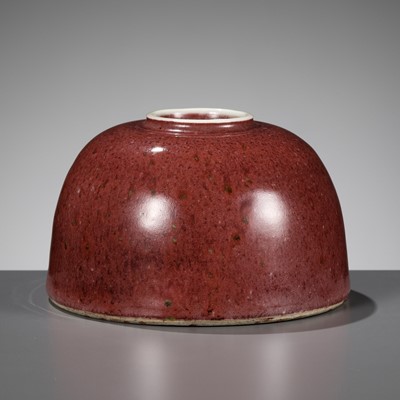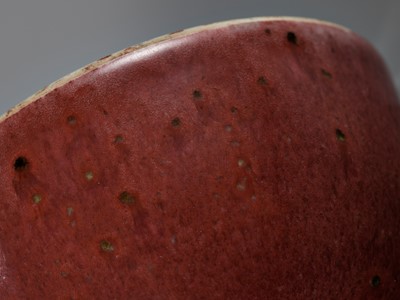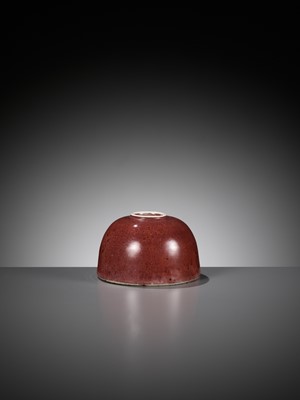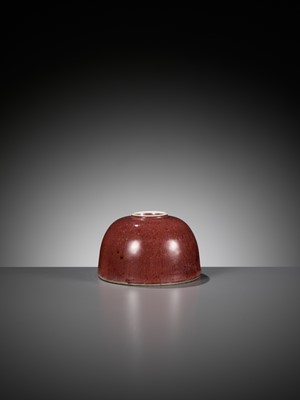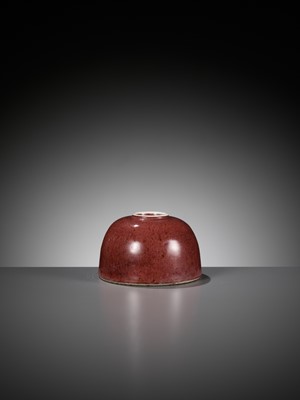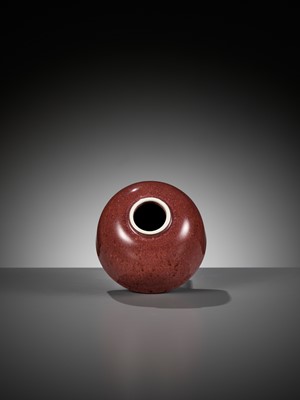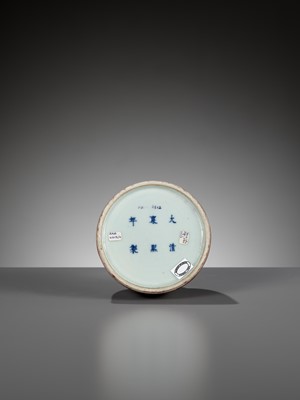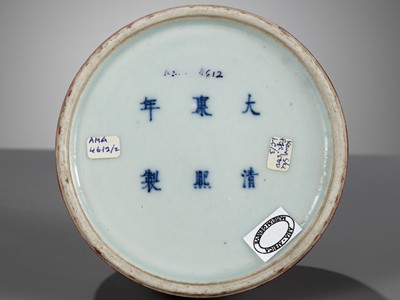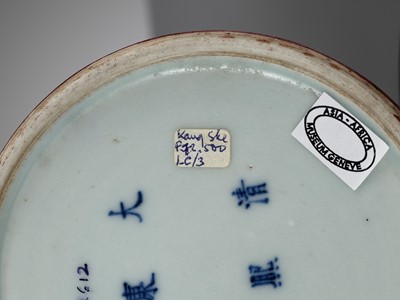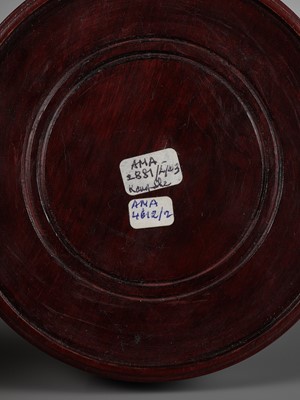2nd Jun, 2023 11:00
Fine Chinese Art / 中國藝術集珍 / Buddhism & Hinduism
105
A PEACHBLOOM-GLAZED ‘BEEHIVE’ WATERPOT, 19TH CENTURY
十九世紀豇豆紅釉水丞
Sold for €3,380
including Buyer's Premium
China. The domed body with short waisted neck and slightly everted rim, the exterior covered in a mottled raspberry glaze interspersed with green copper oxide splashes, a band of raspberry glaze around the inner rim, the interior and base covered in a white glaze.
Provenance: From a noted private collection in Geneva, Switzerland, assembled since the 1960s, and thence by descent. An important part of this collection was on permanent loan and exhibited over several decades at the Asia-Africa Museum in Geneva. The base with three old labels, ‘Kang Shi F72.500 LC/3’, ‘AMA 4612/2’, and ‘Asia-Africa Museum Geneve’, and a lacquered inventory number, ‘[…]612’. The wood stand with two old labels, ‘AMA 2881/L/03 Kang-Shi’ and ‘AMA 4612/2’ to the top and three old labels, ‘AMA 2881 HC3 Kang-Shi’, ‘AMA 4612/2’ and ‘Lum Chai 28831’ to the underside. A copy of a handwritten entry in the inventory of the collection, describing the present waterpot, accompanies this lot.
Condition: Very good condition with minor wear and manufacturing flaws including pitting. The wood stand with minor wear.
Weight: 360.0 g (excl. stand), 477.1 g (incl. stand)
Dimensions: Diameter 10.7 cm (excl. stand), 11.5 cm (incl. stand)
With a carved wood stand of circular form with four feet, dating from the same period. (2)
The recessed base with an apocryphal underglaze-blue six-character mark da Qing Kangxi nianzhi.
The peachbloom glaze has been the focus of scientific research since the mid-20th century. Both the overall soft pinkish red of the glaze, and the areas of clear green which appear to a greater or lesser extent within it owe their hue to copper. Firing in a reducing atmosphere creates the red color, while re-oxidation creates the green. This was therefore a glaze that had to be applied very precisely and fired with great care. Research suggests that a copper-lime pigment was applied between two layers of colorless glaze. The copper-lime pigment was applied by blowing through a bamboo tube with fine silk gauze over the end to achieve an effect similar to modern spraying techniques. This allowed the thickness of the copper-lime layer to be adjusted so that some areas would be thicker than others. In those thicker areas, there was additional flux, which thinned the upper glaze layer and allowed the copper to re-oxidize and produce clear green. In the other areas, some of the pigment was undissolved making it appear slightly opaque and yet smooth on the surface, while the majority of the copper did dissolve and produced a rich pinkish red and creating one of the most highly esteemed glazes from the Qing imperial kilns.
十九世紀豇豆紅釉水丞
中國,圓唇,無頸,半球狀腹,圈足。通體施豇豆紅釉,口與圈足施白釉。
來源:瑞士日內瓦知名私人收藏,自 1960 年代開始收集,保存至今。該收藏的一個重要部分被永久借出,並在日內瓦的亞非博物館展出了幾十年。底足三個標籤 ‘Kang Shi F72.500 LC/3’,‘AMA 4612/2’,與 ‘Asia-Africa Museum Geneve’,以及一個庫存編號 ‘[…]612’。木底座上有兩個標籤 ‘AMA 2881/L/03 Kang-Shi’ 與 AMA ‘4612/以及底部三個標籤 ‘AMA 2881 HC3 Kang-Shi’,‘AMA 4612/2’ 與‘Lum Chai 28831’ 。隨附一份進入收藏的手寫庫存單複印件。
品相:狀況極好,有輕微磨損和製造缺陷,包括點蝕。木架有輕微磨損。
重量:360.0 克 (不含底座),477.1 克 (含底座)
尺寸:直徑10.7 厘米 (不含底座),11.5 厘米 (含底座)
來自同時期的四足雕刻木底座。 (2)
圈足内仿“大清康熙年製“六字款。
紅釉是以氧化銅為著色劑,燒製時先在坯上施一層底釉,然後吹上一層顏色釉料,再蓋上一層面釉,入窯高溫還原焰燒成,呈色變化較多。最早出現於唐代的長沙窯。元代始成功地燒製出紅釉器物。明代永樂、宣德時燒製出著名的“寶石紅”釉。清代康熙時,在繼承前代的基礎上不斷創新,先後燒製出郎窯紅、豇豆紅和霽紅。其中以豇豆紅的燒製難度最大,在淡雅的釉色中有萬千變化,基本無大件器物。
China. The domed body with short waisted neck and slightly everted rim, the exterior covered in a mottled raspberry glaze interspersed with green copper oxide splashes, a band of raspberry glaze around the inner rim, the interior and base covered in a white glaze.
Provenance: From a noted private collection in Geneva, Switzerland, assembled since the 1960s, and thence by descent. An important part of this collection was on permanent loan and exhibited over several decades at the Asia-Africa Museum in Geneva. The base with three old labels, ‘Kang Shi F72.500 LC/3’, ‘AMA 4612/2’, and ‘Asia-Africa Museum Geneve’, and a lacquered inventory number, ‘[…]612’. The wood stand with two old labels, ‘AMA 2881/L/03 Kang-Shi’ and ‘AMA 4612/2’ to the top and three old labels, ‘AMA 2881 HC3 Kang-Shi’, ‘AMA 4612/2’ and ‘Lum Chai 28831’ to the underside. A copy of a handwritten entry in the inventory of the collection, describing the present waterpot, accompanies this lot.
Condition: Very good condition with minor wear and manufacturing flaws including pitting. The wood stand with minor wear.
Weight: 360.0 g (excl. stand), 477.1 g (incl. stand)
Dimensions: Diameter 10.7 cm (excl. stand), 11.5 cm (incl. stand)
With a carved wood stand of circular form with four feet, dating from the same period. (2)
The recessed base with an apocryphal underglaze-blue six-character mark da Qing Kangxi nianzhi.
The peachbloom glaze has been the focus of scientific research since the mid-20th century. Both the overall soft pinkish red of the glaze, and the areas of clear green which appear to a greater or lesser extent within it owe their hue to copper. Firing in a reducing atmosphere creates the red color, while re-oxidation creates the green. This was therefore a glaze that had to be applied very precisely and fired with great care. Research suggests that a copper-lime pigment was applied between two layers of colorless glaze. The copper-lime pigment was applied by blowing through a bamboo tube with fine silk gauze over the end to achieve an effect similar to modern spraying techniques. This allowed the thickness of the copper-lime layer to be adjusted so that some areas would be thicker than others. In those thicker areas, there was additional flux, which thinned the upper glaze layer and allowed the copper to re-oxidize and produce clear green. In the other areas, some of the pigment was undissolved making it appear slightly opaque and yet smooth on the surface, while the majority of the copper did dissolve and produced a rich pinkish red and creating one of the most highly esteemed glazes from the Qing imperial kilns.
十九世紀豇豆紅釉水丞
中國,圓唇,無頸,半球狀腹,圈足。通體施豇豆紅釉,口與圈足施白釉。
來源:瑞士日內瓦知名私人收藏,自 1960 年代開始收集,保存至今。該收藏的一個重要部分被永久借出,並在日內瓦的亞非博物館展出了幾十年。底足三個標籤 ‘Kang Shi F72.500 LC/3’,‘AMA 4612/2’,與 ‘Asia-Africa Museum Geneve’,以及一個庫存編號 ‘[…]612’。木底座上有兩個標籤 ‘AMA 2881/L/03 Kang-Shi’ 與 AMA ‘4612/以及底部三個標籤 ‘AMA 2881 HC3 Kang-Shi’,‘AMA 4612/2’ 與‘Lum Chai 28831’ 。隨附一份進入收藏的手寫庫存單複印件。
品相:狀況極好,有輕微磨損和製造缺陷,包括點蝕。木架有輕微磨損。
重量:360.0 克 (不含底座),477.1 克 (含底座)
尺寸:直徑10.7 厘米 (不含底座),11.5 厘米 (含底座)
來自同時期的四足雕刻木底座。 (2)
圈足内仿“大清康熙年製“六字款。
紅釉是以氧化銅為著色劑,燒製時先在坯上施一層底釉,然後吹上一層顏色釉料,再蓋上一層面釉,入窯高溫還原焰燒成,呈色變化較多。最早出現於唐代的長沙窯。元代始成功地燒製出紅釉器物。明代永樂、宣德時燒製出著名的“寶石紅”釉。清代康熙時,在繼承前代的基礎上不斷創新,先後燒製出郎窯紅、豇豆紅和霽紅。其中以豇豆紅的燒製難度最大,在淡雅的釉色中有萬千變化,基本無大件器物。
Zacke Live Online Bidding
Our online bidding platform makes it easier than ever to bid in our auctions! When you bid through our website, you can take advantage of our premium buyer's terms without incurring any additional online bidding surcharges.
To bid live online, you'll need to create an online account. Once your account is created and your identity is verified, you can register to bid in an auction up to 12 hours before the auction begins.
Intended Spend and Bid Limits
When you register to bid in an online auction, you will need to share your intended maximum spending budget for the auction. We will then review your intended spend and set a bid limit for you. Once you have pre-registered for a live online auction, you can see your intended spend and bid limit by going to 'Account Settings' and clicking on 'Live Bidding Registrations'.
Your bid limit will be the maximum amount you can bid during the auction. Your bid limit is for the hammer price and is not affected by the buyer’s premium and VAT. For example, if you have a bid limit of €1,000 and place two winning bids for €300 and €200, then you will only be able to bid €500 for the rest of the auction. If you try to place a bid that is higher than €500, you will not be able to do so.
Online Absentee and Telephone Bids
You can now leave absentee and telephone bids on our website!
Absentee Bidding
Once you've created an account and your identity is verified, you can leave your absentee bid directly on the lot page. We will contact you when your bids have been confirmed.
Telephone Bidding
Once you've created an account and your identity is verified, you can leave telephone bids online. We will contact you when your bids have been confirmed.
Classic Absentee and Telephone Bidding Form
You can still submit absentee and telephone bids by email or fax if you prefer. Simply fill out the Absentee Bidding/Telephone bidding form and return it to us by email at office@zacke.at or by fax at +43 (1) 532 04 52 20. You can download the PDF from our Upcoming Auctions page.
How-To Guides
How to Create Your Personal Zacke Account
How to Register to Bid on Zacke Live
How to Leave Absentee Bids Online
How to Leave Telephone Bids Online
中文版本的操作指南
创建新账号
注册Zacke Live在线直播竞拍(免平台费)
缺席投标和电话投标
Third-Party Bidding
We partner with best-in-class third-party partners to make it easy for you to bid online in the channel of your choice. Please note that if you bid with one of our third-party online partners, then there will be a live bidding surcharge on top of your final purchase price. You can find all of our fees here. Here's a full list of our third-party partners:
- 51 Bid Live
- EpaiLive
- ArtFoxLive
- Invaluable
- LiveAuctioneers
- the-saleroom
- lot-tissimo
- Drouot
Please note that we place different auctions on different platforms. For example, in general, we only place Chinese art auctions on 51 Bid Live.
Bidding in Person
You must register to bid in person and will be assigned a paddle at the auction. Please contact us at office@zacke.at or +43 (1) 532 04 52 for the latest local health and safety guidelines.

